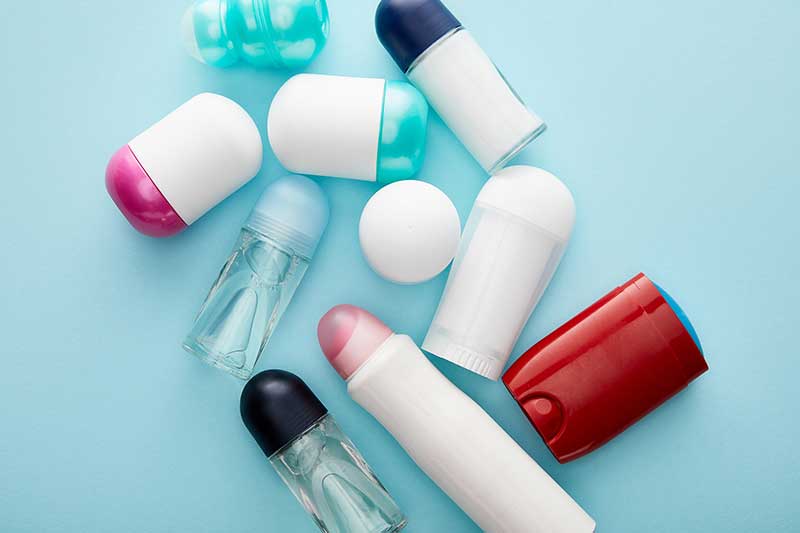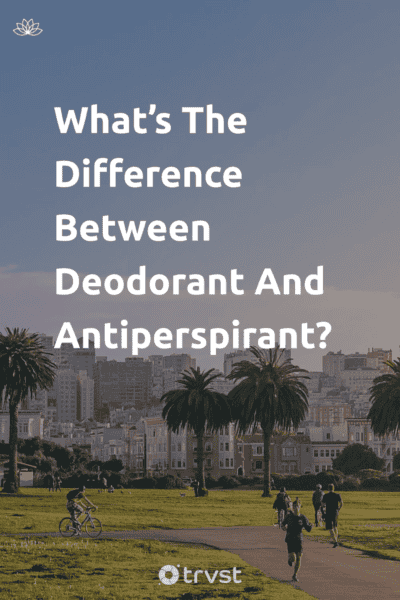What’s The Difference Between Deodorant And Antiperspirant?
It’s easy to confuse deodorants for antiperspirants and vice versa, and many might not even realize there is a difference. However, they have different functions—the first masks body odor, while the other aims at reducing sweat. To maximize the benefits and purposes of these products, we need to understand what differentiates them.
This article explores the key differences between antiperspirants and deodorants. It also explores the ingredients used in each product and their effect on the skin and body.
And as finished, if you’re keen to shun some of the more commercial products below and choose those with lower waste and natural ingredients, check out our guide to zero-waste deodorants.
Key differences between antiperspirant and deodorant

Deodorants mask body odor
Deodorant is a cosmetic product used to control odor from sweating. It is typically alcohol-based. Body odor occurs when the sweat glands produce sweat, and bacteria break the compounds in the sweat down. Our sweat is mostly odorless until bacteria ferments its organic components.
Body odor varies by person. Some are stronger and more noticeable. Deodorants work to control body odor by turning your skin acidic, making it undesirable for bacteria. Also, most deodorants contain perfume that helps you smell fresh.
Fun Fact: Mum was the first commercial deodorant developed in 1888, and before deodorant existed, people used perfume to mask unpleasant odors.
An antiperspirant blocks sweat glands
We have two types of sweat glands: eccrine and apocrine sweat glands. The eccrine sweat ducts produce watery and odorless sweat on the skin's surface, while the apocrine glands produce oily and heavy sweat in the armpit and groin area. Underarm sweat contains waste proteins, fatty acids, and carbohydrates. Bacteria then interact with these waste compounds, leading to body odor.
Unlike deodorants, antiperspirants reduce sweat, thus preventing odor-causing bacteria. This is great for people who sweat excessively and want to avoid underarm wetness. Antiperspirants typically contain an active ingredient, usually aluminum-based compounds. The aluminum compounds help block sweat glands and prevent sweating over a period.
Fun Fact: the United States Food and Drug Administration classifies antiperspirant products as over-the-counter drugs.
The ingredients in deodorant and antiperspirant

Let us examine the ingredients used in the production of deodorant and antiperspirant for odor protection.
1. Aluminum compounds
The manufacturers of antiperspirants use aluminum compounds as the active ingredient because it effectively blocks the sweat ducts in the body. It temporarily halts the production of sweat, reducing the sweat released from your armpit. The common forms of aluminum used in antiperspirants to reduce sweating include aluminum chloride and aluminum zirconium.
However, there have been concerns about the danger aluminum poses to the skin. Some claim that using aluminum-based compounds in antiperspirants increases the risk of breast cancer. Still, the American Cancer Society claims there isn’t any scientific evidence that shows that antiperspirants have a connection to breast cancer.
Impacts of aluminum on our bodies
Researchers could not determine if aluminum increases breast cancer risk in a research study conducted in 2017. They asked over a hundred women the duration and frequency of their use of antiperspirants.
A group diagnosed with breast cancer used antiperspirant multiple times daily, while the other group without breast cancer said they don’t use it often. However, both groups of women had aluminum salts in their breast cells, but the women with breast cancer had more levels of aluminum in their breast tissues than the other group3.
Another research study conducted in 2018 shows that too much aluminum can change the estrogen receptors in the body1. And changes in your hormone system can be harmful over time.
Other research materials claim that the skin doesn’t absorb enough aluminum to cause harm to the body5. There is no proven link between aluminum and antiperspirant. A lot more research still needs to be done regarding this area to be conclusive one way or the other.
Also, you might have heard claims that aluminum increases the risk of kidney disease. This claim is false. The National Kidney Foundation spokesperson, nephrologist Leslie Spry, states that the kidney cannot absorb aluminum. In fact, the kidney's function is to expel aluminum and other waste products from your body.
However, the Food and Drug Administration (FDA) set a rule for manufacturers to add a warning for people with kidney diseases on their labels. The censure states that persons with kidney problems should talk to their doctor first before they apply antiperspirant.
2. Parabens
Manufacturers commonly use parabens, commonly known as hormone-mimicking chemicals, to prevent fungi, bacteria, and yeast from growing on deodorants. You might not like the use of parabens in deodorant because of the effects it has on the body.
Your skin can absorb parabens, and it can mimic the functions of the estrogen hormone. Estrogen is an important hormone for sexual, breast, and brain health in women, while estrogen regulates sex drive and sperm production in men.
Exposure to high amounts of paraben can increase your risk of developing breast cancer, but the amount of parabens used in cosmetic products isn’t enough to increase your risk of getting breast cancer2.
3. Triclosan
Triclosan is a lipophilic compound with antimicrobial properties used to reduce or prevent bacterial contamination in antibacterial soap, toothpaste, antiperspirant, and deodorant. There are no reports of any adverse effects from using deodorants with triclosan4.
4. Phthalates
Phthalates are chemical compounds developed to make plastic more durable. The compounds, also known as plasticizers, are odorless and colorless. These chemicals do not completely evaporate or fuse with the plastic. So they can leak into the contents inside the deodorant bottles.
No established health risks are attached to phthalates in cosmetic products like antiperspirants and deodorants. The National Toxicology Program created an expert panel to examine the potential dangers of phthalates between 1998 to 2000. The panel concluded that there are little to no reproductive health risks from exposure to phthalates.
5. Fragrances
Most manufacturers of antiperspirants and deodorants use artificial fragrances in their products. However, in the main, they do not reveal the components used to make these fragrances. So, we don’t know if they are safe for our skin. Fragrances in skin care products are a common cause of some people's allergic contact dermatitis (ACD).
6. Alcohol
You'll find one or two types of alcohol, like ethanol and isopropyl, in deodorant and antiperspirant. Manufacturers include alcohol in their manufacture because they are fast-drying agents. That's why your roll-on and aerosol spray feels cool and dry within seconds when you apply it.
Things to consider before getting deodorant or an antiperspirant
Before you buy antiperspirant and deodorant, there are certain things you must consider. You must consider what you need it for. Do you want to reduce body odor or control sweat?
Both antiperspirant and deodorant work to reduce odor. Deodorants work to reduce odor by fighting the bacteria that cause it, while antiperspirants work by blocking sweat pores over a period. Antiperspirants prevent sweat and, by extension, prevent bacteria that cause body odor.
However, consider antiperspirants if you want to stop sweating. Many people have hyperhidrosis, a conduction that occurs when the sweat pores are overactive. Prescription antiperspirants work best for people with this condition.
The next thing to consider is the type of deodorant and antiperspirant to get. Both antiperspirants and deodorants come in different forms like gel, stick, roll-on, and spray. You can buy these different types and pick the one you’re comfortable with.
Also, you must check the ingredients of the antiperspirants and deodorants you are purchasing. As mentioned in the previous sections of the article, some ingredients used to produce deodorants and antiperspirants are harmful to your skin and body. Some ingredients might cause skin irritation. Be sure to scrutinize them.
Last, watch out for the alcohol content in your deodorant. When you apply deodorant, and the skin around your armpit dries out, it has a high alcohol content. So, avoid deodorants with a lot of alcohol should you experience dry underarm skin.
What are natural deodorants?
Natural deodorants are products free of alcohol, aluminum, paraben, and other chemical substances. Instead, they contain natural skincare ingredients like baking soda, cornstarch, arrowroot powder, coconut oil, tea tree oil, zinc, and other essential oils.
As a natural alternative to regular deodorant, they are gentler on the skin, help minimize bad body odor and keep you smelling fresh. With natural deodorants, you have lesser stains on your clothes, unlike deodorants with chemical ingredients. Also, you can neutralize your body odor with natural scents.
Conclusion
It is necessary to know and understand the purpose of an item before buying it. Many of us purchase deodorants and antiperspirants without understanding their purposes and checking their active ingredients. You now know that deodorants work for your armpits to smell nice, and antiperspirant reduces or stops sweat.
If you struggle with body odor and excessive sweating, you can get both deodorants and antiperspirants. Many brands offer a 2-in-1 package combining the functions of deodorant and antiperspirant into one product. Choose what’s best for you.
| 1 |
Gorgogietas VA, Tsialtas I, Sotiriou N, Laschou VC, Karra AG, Leonidas DD, Chrousos GP, Protopapa E, Psarra AG. Potential interference of aluminum chlorohydrate with estrogen receptor signaling in breast cancer cells. J Mol Biochem. 2018;7(1):1-13. |
| 2 |
Harvey, P.W. (2003), Parabens, oestrogenicity, underarm cosmetics and breast cancer: a perspective on a hypothesis. J. Appl. Toxicol., 23: 285-288. |
| 3 |
Use of Underarm Cosmetic Products in Relation to Risk of Breast Cancer: A Case-Control Study |
| 4 |
Lee, J.D., Lee, J.Y., Kwack, S.J. et al. Risk Assessment of Triclosan, a Cosmetic Preservative. Toxicol Res. 35, 137–154 (2019). |
| 5 |
Klotz K, Weistenhöfer W, Neff F, Hartwig A, van Thriel C, Drexler H. The Health Effects of Aluminum Exposure. Dtsch Arztebl Int. 2017 Sep 29;114(39):653-659. doi: 10.3238/arztebl.2017.0653. |
Jen’s a passionate environmentalist and sustainability expert. With a science degree from Babcock University Jen loves applying her research skills to craft editorial that connects with our global changemaker and readership audiences centered around topics including zero waste, sustainability, climate change, and biodiversity.
Elsewhere Jen’s interests include the role that future technology and data have in helping us solve some of the planet’s biggest challenges.

